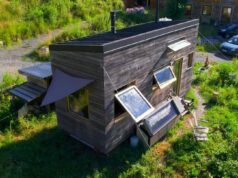The Fairey Rotodyne was a 1950s British compound gyroplane designed and built by Fairey Aviation and intended for commercial and military uses. A development of the earlier Fairey Jet Gyrodyne, which had established a world helicopter speed record, the Rotodyne featured a tip-jet-powered rotor that burned a mixture of fuel and compressed air bled from two wing-mounted Napier Eland turboprops. The rotor was driven for vertical takeoffs, landings and hovering, as well as low-speed translational flight, but autorotated during cruise flight with all engine power applied to two propellers.
source.image: Mustard
The Rotodyne might have looked like part helicopter, part plane, but it was actually neither. Where a helicopter uses engine power to spin a rotor blade to force air down and create lift, on a Rotodyne the large rotor wasn’t directly driven by a motor. Instead it used a freely-spinning rotor called an autogyro. As air passed naturally through the rotor blades during flight, it caused the rotor spin around like a pinwheel to create lift.
The Rotodyne still had wings and a pair of turboprops much like an airplane. But in forward flight, the unpowered spinning rotor lifted more than half the aircraft’s weight. To take off and land vertically and hover, tip jets at the end of each rotor blade would be used to spin up the Rotodyne’s rotor. Once in forward flight, the tip jets were shut off and the rotor would once again spin freely.
Advertisement
When the first Rotodyne prototype took to the skies, it could carry 40 passengers over 700km and reach speeds of over 300km/h, all while being able to land and take off on a space not much larger than the aircraft itself. And after 350 successful test flights, the Rotodyne proved to be safe and capable. But despite plans for an even larger more powerful version, a combination of noise concerns and lack of government support for research and development ultimately led to cancellation of the project.











